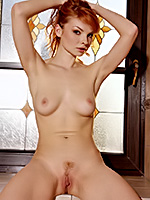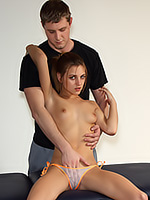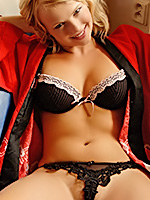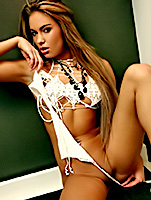have had two encounters with Oscar-winning director, Kathryn Bigelow, and both of them made an indelible -- and unsettling -- impression.
In each instance, one was aware of her simmering anger. This driven filmmaker was not to be trifled with and any acceptance she received in the industry had to be on her terms.
On Sunday, she became the first female director to receive an Academy Award, for the gritty Iraq drama, The Hurt Locker.
But the greater significance of this victory lay in the fact that she won with the kind of movie she wanted to make -- a movie reflecting a violent macho sensibility. Much of her anger over the years seems to have stemmed from her resentment over complaints that she -- a woman -- should not be making films like this.
I watched this resentment explode into fury 15 years ago in New York, when Bigelow met the press to defend Strange Days, a violent, nightmarish vision of Los Angeles on the eve of the millennium. Her outburst was triggered by a female journalist who accused Bigelow of gross irresponsibility for making a movie that could encourage violence against women.
"How dare you!" an outraged Bigelow exclaimed. Her anger was palpable. Later in the day, she cornered the reporter again and berated her for daring to ask such a question.
Back in 1995, Strange Days polarized critics and audiences. Roger Ebert may have called it one of the best movies of the year, but The New Yorker's Anthony Lane found it more unpleasant than Showgirls.
In Canada, The Vancouver Sun condemned it for its hatred of women. A furious Calgary Herald critic complained of a scene "filmed from the exact point of view of the rapist-murderer: He breaks into a woman's apartment, handcuffs and blindfolds her, slices her clothing so her breasts are exposed (she's only wearing panties and a T-shirt), rapes her, then strangles her to death with her T-shirt. . . . No Canadian will be able to watch this in-your-face horror without thinking of the innocent victims of Paul Bernardo."
Throughout her film career, nobody has been neutral about Bigelow. Even as New York's Museum of Modern Art was hailing her renown as a visual stylist with a retrospective of her first three films, she was being condemned in other circles as a purveyor of nasty, gratuitous violence.
The controversy generated by her movies reached its zenith with Strange Days, a box-office failure that almost finished her career. But even during the hard times, she has never compromised.
My other encounter with Bigelow had occurred five years earlier, in 1990. I was interviewing her about Blue Steel, a blood-spattered action thriller starring Jamie Lee Curtis as a female cop in pursuit of a serial killer.
The uproar this film generated began with its sexually charged opening credits, which had the camera obscenely exploring and caressing every aspect of a .44 Magnum. Montreal Gazette critic John Griffin was incensed, attacking Blue Steel as "blatantly sexist ... strongly misogynistic" and guilty of "undermining the cause of women and common decency on every front."
Bigelow was already upset by the time I talked to her about Blue Steel because of an earlier confrontation with a group of student journalists who had bluntly asked her what she, a woman, thought she was doing making a gory movie like this?
Bigelow has always hated having her gender dragged into the violence debate. Back in 1990, she cited one of her favourite directors, the ultra-macho Walter Hill, who made 48 Hours.
"I mean, if I was sitting here and I was Walter Hill instead of Kathryn Bigelow, people wouldn't be asking me about the violence," she objected.
"What I'm picking up from these questions is that violence is a male domain and I don't agree. . . . I make movies about things that interest me. I'm not trying to beat men at their game. I'm not trying to be the only woman who can make an action movie or whatever."
It was a revealing conversation. Bigelow was guarded but cordial. And then, suddenly, she revealed her short fuse.
A publicist for the film entered the room to retrieve a file, and Bigelow abruptly rose to her full six feet and towered over the poor woman. "You're bothering us!" she snapped. "Get out!" Once the offending publicist had fled, Bigelow settled back in her chair to admit to a fascination with violence in all her movies, from her audacious biker movie, The Loveless, which involves a child who commits suicide after killing the father who's been raping her, to her vampire western, Near Dark.
She was genuinely enthusiastic about the lengths she went to with her first film, a short subject called The Set-Up.
"I was making this movie about two guys beating each other up, and I couldn't afford stunt coordinators, so I asked these two guys to beat each other up for take after take after take.
"We were shooting all night, and at first, they thought it was cool, but by dawn the next morning, when they were both bloody and bruised, they didn't think it was as much fun."
And yes, she loves seductive imagery. "I think you kind of need to massage your viewer before you punch him."
By her standards, Bigelow is a filmmaker of integrity who doesn't compromise her artistic principles.
The Hurt Locker, a brilliantly executed treatise on the macho bomb-disposal culture, is a case in point.
"War's dirty little secret is that some men love it," she said in explaining why she wanted to make The Hurt Locker. An Oscar may have brought her respectability, but the lady remains true to her nature.
Source:vancouversun.com/
skip to main |
skip to sidebar















Erotic Pictures Of The Most Beautiful Nude Grils About In The World, Erotic Pictures Of The Most Beautiful Nude Full Bikini without clothes, just leather only.















Blog Archive
-
▼
2010
(403)
-
▼
March
(53)
- Beautiful young nude body
- Week in Review: More Jesse James Bombshells, Kim a...
- Very hot butt!!!
- Smooth young pussy
- Simple nudes on nature
- Beautiful Strip at home
- Hot sweet pussy
- Large Natural Boobs
- As 'Remember Me' Opens, We Celebrate With Other Me...
- Is The Hurt Locker a harbringer of Iraq war movies...
- Kristen Stewart says 'Twilight Eclipse' includes a...
- Behind director's Hurt Locker
- Preity to spread AIDS awareness via IPL
- Price hunts £1m deal for second wedding
- Remember Me: Young Love, Hold the Vampires
- Children who watch X-rated films 'more likely to d...
- Emma Watson calls it splits with beau
- VH1's 'Price of Beauty,' hosted by Jessica Simpson...
- Sexy erotic pictures
- Nude female person body
- Key moments make 2010 Academy Awards memorable
- Tasteful nude boobs
- Event television scores again with Oscar ratings
- Oscars 2010: Best Actress Sandra Bullock leads in ...
- Ryan O'Neal 'Stunned' by Farrah Fawcett Oscar Snub
- The Hurt Locker, Kathryn Bigelow dominate historic...
- Oscar fashions: Divas and flops on the red carpet
- The Cablevision-Disney Oscar Fight Hints of Things...
- Best Oscar night ever?A funny, dynamic broadcast e...
- Mo’Nique – an accolade bigger than the Oscar
- Sandra: Razzie and Oscar on display
- The popular Mr. Clooney and other Oscar vignettes
- Oscar Night Suspense, Then Poof! Cable’s Back
- Partial list of winners at the 82nd annual Academy...
- 82nd Annual Academy Awards 2010 Oscars WINNERS - F...
- Oscar Award ceremony kicks off with great fanfare
- Basterds' star Waltz wins supporting-actor Oscar
- Sandra Bullock wins Razzie ahead of Oscars ceremony
- 'The Hurt Locker': Box office bomb to best picture?
- Who'll win the Oscars and WHY -- category per cate...
- Hollywood on edge as Oscars countdown begins
- Oscar sets the stage for ladies night
- New Yorkers Can't See the Oscars
- Memorable moments in Oscar hosting history
- 'Thank you for ruining my career with a very bad d...
- Scandal-tainted 'Hurt Locker' favorite for Oscars
- Nice Russian erotica
- Sexy brunette babe
- Pretty nude art erotic photo
- Gold Derby nuggets: Pete Hammond: Best actress 'do...
- Oscar fans may lose in Cablevision-ABC fee dispute
- Oscars: Kim Basinger in, Jeff Bridges out for Hyun...
- Alec's ready. But is Oscar?
-
▼
March
(53)
Labels
- Women (66)
- Fail (58)
- Cool (57)
- Entertainment (54)
- News (54)
- sexy babe (49)
- Funny (47)
- Sexy (43)
- young pussy (42)
- Weird (39)
- erotic beauty (39)
- Sad (37)
- Amazing (36)
- young female (36)
- young nudes (35)
- russian teen (32)
- russian girls (30)
- narural boobs (29)
- pretty women (25)
- nude pics (24)
- nude lady (22)
- Oscar on a Collision (14)
- hot ass (14)
- Oscar Best Foreign Language Film (13)
- Oscar showcase (13)
- Oscar Best Actor (12)
- Oscar Best Documentary (12)
- Oscar Best Director (11)
- Oscar Contenders Praised (11)
- Oscar-Winning Songwriter (11)
- nice body (11)
- sexy blonde (11)
- One-of-a-kind Grammy (10)
- Oscar dream Family (10)
- Oscar Na na (9)
- Grammy 'American Idiot (8)
- Oscar's Ad Rules (8)
- Big Dipper (7)
- Oscar and Chatwal Nobel (7)
- Oscar the cat knows (7)
- Oscar-winner Danny Boyle (7)
- Battle of the exes (6)
- Forever Grammy Awards (6)
- Lindsay Lohan (6)
- Mo'Nique's Oscar Chances? (6)
- Neil Young Grammy (6)
- New Oscar Predictions (6)
- Oscar Best Director nominees (6)
- Oscar Lafontaine (6)
- Oscar Screenplay Categories (6)
- Oscar-nominated roles (6)
- :League of stars (5)
- Big year for Canada (5)
- Bocelli Grammy Haiti relief (5)
- Christmas Father (5)
- Demi Moore Jewish holiday (5)
- Don't Miss This (5)
- Grammy Nod Adds Melanie Fiona (5)
- Grammys producer on Sunday (5)
- Kim Kardashian birthday (5)
- L. Kent Wolgamott Grammy (5)
- Lindsay Lohan's film (5)
- Magic All Stars (5)
- Michelle Obama play (5)
- Oscar Will Never (5)
- Oscar de la Renta (5)
- Oscar-winning Gentleman Agreement (5)
- Ranking Oscar-nominated (5)
- Regis Philbin on 'Live (5)
- Rihanna Grammys Alone (5)
- Top 10 Best Oscar (5)
- list of movie awards Oscars (5)
- 'Crazy Heart' gets Oscar (4)
- 3 Oscar 2010 nominations (4)
- Barbara Billingsley (4)
- Best Actress Sandra Bullock (4)
- Bigger than the Oscar (4)
- Charlize Theron TV show (4)
- Disney closes studio (4)
- Good Morning Oscar (4)
- Haiti charity song (4)
- Jesse James (4)
- La Danse When in Rome' (4)
- Las Vegas Mayor Oscar (4)
- Lindsay Lohan like (4)
- Lindsay Lohan's Things (4)
- Mary (mother of Jesus) (4)
- Michael Douglas (4)
- Michelle Obama (4)
- Oscar for Hangover (4)
- Oscar nominees are? (4)
- Oscar-winner Helen Mirren (4)
- Oscars Try to Navigate (4)
- Royal Wedding (4)
- Sandra Bullock Oscar (4)
- Sandra Bullock wins Razzie (4)
- Screen Shorts (4)
- Thoughts on Oscar Nominations (4)
- 20 Academy Awards’ (3)
- 5 Oscar Movies (3)
- A Rosa Parks? (3)
- Amakhosi Continue Winning Streak (3)
- Chris Brown Assault (3)
- Crazy Oscar Nomination (3)
- Dallas Stars meltdown (3)
- For Colored Girls: Review (3)
- Good for Twilight (3)
- HEAVENLY LOVE (3)
- Jessica Simpson (3)
- Jesus (3)
- Katy Perry (3)
- Lady Gaga (3)
- Less than zero (3)
- Lohan claiming (3)
- Lohan under 'cocaine (3)
- Milan shows (3)
- Miley Cyrus Is Now Officially Britney Spears (3)
- Nightcrawler (3)
- Nominations In Same Week (3)
- Oscar Predicting the nominees (3)
- Oscar Star Trek (3)
- Oscar of India (3)
- Pauly ‘Shore’ (3)
- People's Choice (3)
- Preity AIDS awareness (3)
- Price hunts £1m deal (3)
- Royal romance (3)
- Star light shows (3)
- White-flight image (3)
- Winner Should Be (3)
- Young stars making (3)
- award at the Golden Raspberries (3)
- jennifer-lopez (3)
- 'The Hurt Locker (2)
- 'Twilight Eclipse' includes a wig: (2)
- 15 Biggest Sundance (2)
- 2010 Grammy predictions (2)
- AVATAR Oscar Movies (2)
- Actor in Israel's Oscar (2)
- Angelina Jolie Set to Play (2)
- Angry on 'Dancing (2)
- Award lead to Oscar (2)
- Barbara Billingsley--- (2)
- Best Oscar night ever? (2)
- Black stars (2)
- Bollywood bug (2)
- Braveheart Lethal Weapon (2)
- Britney Spears on Glee (2)
- But is Oscar? (2)
- Can't See the Oscars (2)
- Children watch X-rated (2)
- Chippy Movie (2)
- Christina Ricci (2)
- Christmas worldwide (2)
- Costume Designers nominees (2)
- Daylight savings end (2)
- Demi Lovato (2)
- Due Date – review (2)
- Easy Movie (2)
- Eclipse stars (2)
- Eddie Cibrian`s scorned ex-wife (2)
- Eyeing the Oscars (2)
- Facts about Kate Middleton (2)
- Farrah Fawcett Oscar (2)
- Final Larry King Live (2)
- First Lady (2)
- Fraud by Adviser to Stars (2)
- Friday Box Office (2)
- Gisele Bundchen pregnancy (2)
- Grey Leads (2)
- Heads to Haiti (2)
- Hear that (2)
- Hold the Vampires (2)
- Hurt Locker a harbringer (2)
- I may not Grammys (2)
- Irish stars Golden Globes nominees (2)
- Jessica Alba (2)
- Jill Clayburgh Dies (2)
- Jolie ‘Leak (2)
- Jusin Bieber (2)
- Kanye West Update (2)
- Kardashian keep her clothes on (2)
- Kim Kardashian Kicks (2)
- Kirsten Dunst To Taylor Swift (2)
- Kristen Stewart (2)
- Lil Wayne (2)
- Lil Wayne Just Yet (2)
- Lindsay Up Too (2)
- Lovie Smith (2)
- Marry in 2011:Prince William and Kate (2)
- Miley Cyrus (2)
- Myself winning Gramm (2)
- New This Week (2)
- New album are fake (2)
- Nicholas Sparks (2)
- Obama to celebrate Diwali (2)
- Oscar beckons for Weta team (2)
- Oscar of old again (2)
- Oscars Try to Babel (2)
- Oscars and WHY (2)
- Oscars countdown begins (2)
- People's Choice Awards (2)
- Raspberry nominations (2)
- Reaction from Oscar nominees (2)
- Richard Attenborough wins (2)
- Sexiest Movie Stars (2)
- Sexy Stars (2)
- Shah Rukh Khan on CNN (2)
- Sharon Stone (2)
- Sherlock Stars (2)
- Smith Talks Politics (2)
- Stars in NASA mission (2)
- Sundance Film Festival (2)
- Swell season Grammy watch (2)
- Top Critics Activates (2)
- Top Ten list for Conan (2)
- Tron Opens (2)
- Twihard living (2)
- Understudies to the Stars (2)
- Walk of Fame (2)
- When Enuf Is Too Much (2)
- Who will win Newbery Monday? (2)
- X Factor stars (2)
- perfection beautiful (2)
- ‘The Princess and the Frog (2)
- 'New' Michael Jackson Track (1)
- 'Tori and Dean (1)
- 2010 memorable (1)
- 2011 Golden Globe (1)
- 5 Ways to Grammy (1)
- 50 Cent (1)
- 9/11 Truther (1)
- A stat from 80s (1)
- ABC fee dispute (1)
- About Remembering Stuff (1)
- Alicia Keys gives (1)
- Amanda Peet (1)
- Amazing Acid victim Katie Piper poses for glamorous magazine (1)
- Amitabh Bachchan supports (1)
- Amy Adams (1)
- Anna May Wong (1)
- Anna Nicole Smith's boyfriend (1)
- Anne Hathaway Oscar nominations (1)
- Annual Academy Awards (1)
- Apple iPhone (1)
- Axl Rose (1)
- Barbara Billingsley: 'Leave (1)
- Behind Hurt Locker (1)
- Ben Affleck and Rebecca Hal (1)
- Black Eyed (1)
- Blue Heelers (1)
- Body painting (1)
- Breast cancer facts (1)
- Brett Favre (1)
- Britney Spears Conservatorship (1)
- Bruce Allen (1)
- Bruce Willis (1)
- CHILDHOOD STARS - THEN NOW (1)
- Cablevision Systems (1)
- Camera (1)
- Camille Grammer (1)
- Campbell Brown (1)
- Christmas (1)
- Colony" and "The Women's Kingdom" (1)
- Crystal Bowersox (1)
- Curious Oscar theory (1)
- DWTS exit (1)
- Daniel M. Snyder (1)
- David Beckham (1)
- Dax Shepard (1)
- Democratic Messaging Obama (1)
- Douglas Murray (1)
- Egyptian soul (1)
- Elizabeth Edwards (1)
- Emily Watson (1)
- Eminem And Lil Wayne (1)
- Emma Watson (1)
- Ethiopians Tulu (1)
- Famous Birthdays (1)
- Fiona Phillips (1)
- Frank Sinatra (1)
- Full Abiies (1)
- George Halas (1)
- George W. Bush (1)
- Girl Who Kicked (1)
- Gloria Stuart profile (1)
- Gloria Swanson (1)
- Golden Globes (1)
- Google Limits (1)
- Great Migrations (1)
- Greta Garbo (1)
- Hedy Lamarr (1)
- Hijab (1)
- Historic Oscars night (1)
- History of the camera (1)
- Hollywood breast cancer campaign (1)
- Hollywood executives jailed (1)
- Hollywood’s New Formula (1)
- Holmes in crime (1)
- Hot Ticket Oscars (1)
- Hot in Cleveland (1)
- How old is Sophia Loren ? (1)
- Hugh Hefner (1)
- Human rights (1)
- IMAGINED OSCAR SNUB (1)
- Ilene Woods (1)
- In Locker 10 things Oscar (1)
- Inside Courteney Cox (1)
- International Film Festival (1)
- Irv Eatman (1)
- J-1 visa (1)
- J-2 visa (1)
- Jackass 3D (1)
- Jackson sight (1)
- Jaime Pressly Arrested (1)
- Jami Gertz (1)
- Jeff Bridges (1)
- Jennifer Grey (1)
- Jennifer Hudson (1)
- Jennifer Jones (1)
- Jerry Angelo (1)
- Jets Flight Crew (1)
- Jim Edmonds (1)
- Jimi Heselden (1)
- Jodie Fisher (1)
- John Stamos (1)
- Johnny Weir (1)
- Katy Perry Lands (1)
- Kay Francis (1)
- Kennedy miniseries (1)
- Kerala didn't nominate (1)
- Kids Are All Right (1)
- King's Speech (1)
- Laurence Olivier (1)
- Lawyer (1)
- Lena Horne (1)
- Lenna (1)
- Lily Allen (1)
- Lily Rabe (1)
- Lisandro López (1)
- Maia Campbell (1)
- Marcia Cross (1)
- Mariah Carey Pregnancy (1)
- Mark Hurd (1)
- Mark Murphy (1)
- Marlene Dietrich (1)
- Martina Hingis (1)
- Marvin Sapp (1)
- Megamind' Opens (1)
- Melvyn Douglas (1)
- Merle Oberon (1)
- Michael Bolton (1)
- Michael Edward Shanahan (1)
- Michael Grimm (1)
- Michael Jackson's Home (1)
- Michele Bundy (1)
- Michelle Pfeiffer (1)
- Mickie James (1)
- Mike McCarthy (1)
- Mike Tannenbaum (1)
- Miranda Kerr (1)
- Miss USA (1)
- Miss Universe (1)
- NBC Universal and CNN (1)
- New New Yorker (1)
- Nick Lachey And Vanessa Minnillo (1)
- Nicole Kidman and Keith Urban (1)
- Nirmohi Akhara (1)
- Omar Minaya (1)
- Oprah Winfrey (1)
- Oscar (1)
- Oscar figures and milestones (1)
- Oscar Award kicks (1)
- Oscar Fight Hints (1)
- Oscar Night Suspense (1)
- Oscar fashions (1)
- Oscar hosting history (1)
- Oscar on display (1)
- Oscar ratings (1)
- Oscar sets the stage (1)
- Oscar vignettes (1)
- Oscars WINNERS - Full List (1)
- Oscars leading men (1)
- Oscars telecast details (1)
- Oscars: Kim Basinger out for Hyundai (1)
- Paas Akey (1)
- Paula Abdu (1)
- Pauline Hanson (1)
- Pentatomoidea (1)
- People's Choice Eclipses (1)
- Phoebe Cates (1)
- Pope (1)
- Pre-Oscar (1)
- Profile facts (1)
- Quran on 9/11 (1)
- Rachel Maddow on suspended (1)
- Rachel Stevens (1)
- Rachel Zoe on (1)
- Rapper T.I. (1)
- Raven-Symone weight loss (1)
- React To Oscar Nominations (1)
- Responses to 9/11 (1)
- Rex Ryan (1)
- Right news for sell (1)
- Robert De Niro (1)
- Robert Walker (1)
- Ronaldinho (1)
- Royal Date Night (1)
- Sachin Tendulkar (1)
- Sarah Palin Tells Bristol (1)
- Saul Alvarez (1)
- Scandal-tainted Hurt Locker (1)
- Season 36 (1)
- Semi Final Stars (1)
- Serena Williams (1)
- Sex allegations on church (1)
- Sharon Stone Basic actress (1)
- Snow Cancels Lady Gaga (1)
- Social relation (1)
- Sonal Mehta out-of-court settlement? (1)
- Sonia Ferrer (1)
- Spider-Man injured (1)
- Splits with beau (1)
- Stan Lee (1)
- Stella Adler (1)
- Super Bowl Plans (1)
- TRON: Legacy (1)
- Taylor Swift and Jake (1)
- Ted Thompson (1)
- Ted Williams Brings (1)
- Tees Maar Khan (1)
- The Conspirator (1)
- Thomas Edison (1)
- Tim Tebow (1)
- Tom Cruise (1)
- Tori Spelling (1)
- Tourism (1)
- Travel (1)
- Troy Polamalu (1)
- Tyson Shows Love (1)
- Unreleased Michael Jackson (1)
- Valerie Bertinelli (1)
- Vanessa Hudgens (1)
- Victoria Beckham (1)
- Victoria's Secret (1)
- Vincent Jackson (1)
- Vivien Leigh (1)
- Whittingstall in Switzerland (1)
- Will Smith (1)
- Wins supporting-actor Oscar (1)
- Woody Johnson (1)
- Wudu (1)
- Xbox Kinect (1)
- california highway (1)
- ditzy (1)
- ex scene (1)
- golden voice (1)
- hollywoodnews (1)
- inspires sanitary (1)
